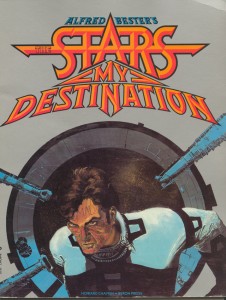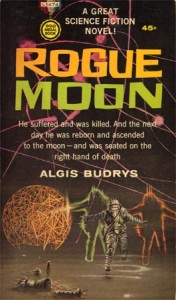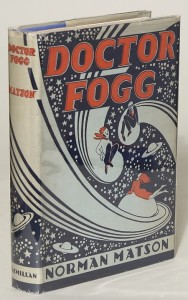The Reading of Recommended Texts is Recommended (but not Compulsory)
I’m obsessed with d-mat. (Does it show?) As well as writing Twinmaker and all the related short stories and urban myths and stuff–having huge fun doing it too, let me tell you–I was working on a PhD examining the history of matter transmitters, with a view to making other people obsessed with them too. Or at least making people aware that they can do a lot more than just beam people about the place and occasionally turn them into flies.
 One of the best bits about going back to university was the research. Yes, really. There are so many old books and stories that use the trope in interesting ways, and I had to read them all. Some of these stories are classics, like Alfred Bester’s The Stars, My Destination or James Patrick Kelly’s “Think like a Dinosaur”, but a lot have dropped out of the public eye, even for readers outside science fiction. And some are so weird they remain memorable only for their WTF qualities.
One of the best bits about going back to university was the research. Yes, really. There are so many old books and stories that use the trope in interesting ways, and I had to read them all. Some of these stories are classics, like Alfred Bester’s The Stars, My Destination or James Patrick Kelly’s “Think like a Dinosaur”, but a lot have dropped out of the public eye, even for readers outside science fiction. And some are so weird they remain memorable only for their WTF qualities.
In this and a number of subsequent posts I’ll list some of my favorites, in no particular order, with brief explanations why. Here goes!
“The Man Without a Body” (Edward Page Mitchell, 1877)
- Plot: Visionary Professor Dummkopf tests his revolutionary “Telepomp” on simple compounds, a stamp, and then a kidnapped cat, but carelessly forgets to charge the machine’s batteries before going through himself, resulting in his body vanishing “Lord knows where”.
- Wonderful madness: There’s a scene at the end where the narrator steals the Professor’s remains (a head, of course, which talks) from its resting place in a museum, gives it a new body in the form of a moa skeleton, dresses it up in colonial outfits, and takes it for a romp in Central Park.
- Extra goodness: This has the distinction of being the first ever published story using a mechanical matter transmitter, so everything in it is capital-n New.
 Rogue Moon (Algis Budrys, 1960)
Rogue Moon (Algis Budrys, 1960)
- Plot: Sadistic scientist uses a “matter scanner” to send suicidal volunteer to explore a dangerous alien maze on the Moon.
- Neat trick: Soon after being duplicated, the original subject and his copy share a psychic link that fades as they diverge into unique individuals.
- Extra goodness: This was a Hugo Award nominee in its year, and I can totally see why. It’s intense and unflinching. I’d love to see it filmed by the makers of Mad Men with proper period stylings, like an alternate-history moon-shot with lots and lots of death.
“Rabbits to the Moon” (Raymond E. Banks, 1959)
- Plot: Venal businessman uses an experimental machine to urgently sign a contract on the moon.
- Wonderful madness: The “Webb Traveleasy” sends everything but bones, which lag behind, so he arrives a hideous blob (and somehow functions just fine).
- Extra madness: Why didn’t they just send the form to him?
Doctor Fogg (Norman Matson, 1929)
- Plot: Eponymous, self-isolated scientist accidentally invents the “X-cast” and brings an alien woman to Earth.
- Neat trick: A series of strange communications drifting through space might actually be from Earth’s distant past, endlessly circulating, and alien to us now.
- Extra goodness: It’s an extended meditation on the distances between people, even when they profess to be in love, and quite moving in that regard. I can’t begin to describe how much I love this book. It’s an entirely unappreciated gem.
 “There is a Crooked Man” (Jack Wodhams, 1967)
“There is a Crooked Man” (Jack Wodhams, 1967)
- Plot: A rich and inventive account of many criminal and accidental uses of “Instravel”.
- So many neat tricks: A traveller arrives radically rearranged; a scientist becomes multiply copied at the expense of other travellers (who disappear); a man and a woman deliberately swap bodies in order to prop up a failing marriage; limbs switch from person to person; some people are allergic to the process; travellers are kidnapped en route; sabotage conducted in the early days of the technology turns out to be the responsibility of a transport company not wanting to lose its monopoly; “OWTE” (one Way Ticket to Eternity) installations spread, basically suicide-booths: a jilted husband uses a concealed booth to get rid of a cheating wife and her lover; an exile returns to his native country in the body of another person; the use of “Instravel Re-Creative Physical Perfectionizing” exists, to repair people who have been scanned into memory; people go to ridiculously complicated means people in order to created nearly unforgeable money.
- Extra goodness: It’s written in a fragmented style that neatly echoes the process of disintegration and reintegration essential to Instravel.
- Bonus extra goodness: Wodhams was an Australian like me and this novella was published the year I was born.
More to come!
(The thumbnail for this post, btw, comes from another cover of Rogue Moon.)
